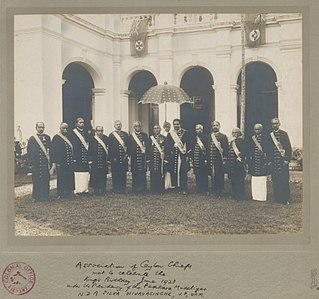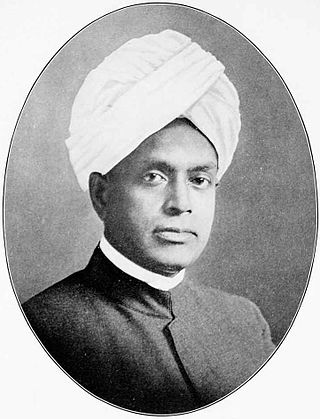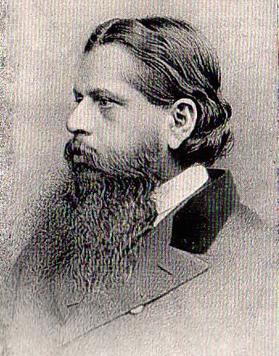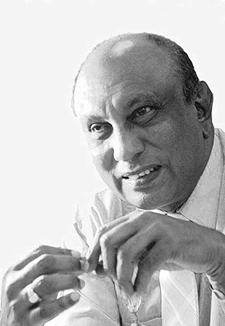Related Research Articles

Ananda Kentish Muthu Coomaraswamy was a Ceylonese metaphysician, historian and a philosopher of Indian art who was an early interpreter of Indian culture to the West. In particular, he is described as "the groundbreaking theorist who was largely responsible for introducing ancient Indian art to the West".

The Mahāvaṃsa is the meticulously kept historical chronicle of Sri Lanka written in the style of an epic poem written in the Pali language. It relates the history of Sri Lanka from its legendary beginnings up to the reign of Mahasena of Anuradhapura covering the period between the arrival of Prince Vijaya from India in 543 BCE to his reign and later updated by different writers. It was composed by a Buddhist monk at the Mahavihara temple in Anuradhapura about the 5th century CE. In 2021, a petition was made to declare the original leaf book a UNESCO heritage.

Ethel Mary Partridge, Ethel Mary Mairet RDI, or Ethel Mary Coomaraswamy was a British hand loom weaver, significant in the development of the craft during the first half of the twentieth century.
The caste systems in Sri Lanka are social stratification systems found among the ethnic groups of the island since ancient times. The models are similar to those found in Continental India, but are less extensive and important for various reasons, although the caste systems still play an important and at least symbolic role in religion and politics. Sri Lanka is often considered to be a casteless or caste-blind society by Indians.

Nandalal Bose was one of the pioneers of modern Indian art and a key figure of Contextual Modernism.

Mudaliyar was a Ceylonese colonial title during Portugese and British rule of the island. Stemming from the native headman system, the title was usually hereditary, made to wealthy influential families loyal to the British Crown.

Senarath Paranavitana, was a Sri Lankan archeologist and epigraphist, who pioneered much of post-colonial archaeology in Sri Lanka. He served as the Commissioner of Archeology from 1940 to 1956 and there after as Professor of Archeology at the University of Ceylon from 1957 to 1961.

Sir Ponnambalam Ramanathan, CMG, KC was a Ceylon Tamil lawyer, politician and Solicitor-General of Ceylon.

Ponnambalam Arunachalam was a Ceylonese civil servant and a member of the Executive Council of Ceylon and Legislative Council of Ceylon.
The Royal India Society was a 20th-century British learned society concerned with India.

Sir Muthu Coomaraswamy was a Ceylon Tamil lawyer, writer and member of the Legislative Council of Ceylon.

Gunapala Piyasena Malalasekera, OBE, JP, was a Sri Lankan academic, scholar and diplomat best known for his Malalasekara English-Sinhala Dictionary. He was Ceylon's first Ambassador to the Soviet Union, Ceylon's High Commissioner to Canada, the United Kingdom and Ceylon's Permanent Representative to the United Nations in New York. He was the Professor Emeritus in Pali and Dean of the Faculty of Oriental Studies.

Deshanabu Tissa Ananda Abeysekara was a Sri Lankan filmmaker, actor, writer, director, screen playwright and political activist. He is better known as a script writer for the cinema as well as a film director. In 1996, his book Bringing Tony Home won the prestigious Gratiaen Prize for the new creative writing in English. He was the chief coordinator of FOSWAL in Sri Lanka and honoured awardee of SAARC Literary Award.
The Royal Asiatic Society of Sri Lanka (RASSL) is based in Colombo, Sri Lanka. It is one of the oldest learned societies in Sri Lanka with a history of over 160 years. It was established on 7 February 1845, paralleling the Royal Asiatic Society of Great Britain and Ireland to further oriental research as the Ceylon Branch of the Royal Asiatic Society. In 1977 it was renamed the Royal Asiatic Society of Sri Lanka.

Lionel George Henricus Wendt was a pianist, photographer, filmmaker and critic from Sri Lanka. He was the leader of ‘43 Group, a collective of Sri Lankan artists.

This is a bibliography of notable works about India.
Amir Hossein Zekrgoo is an Iranian artist, art historian and Indologist. He has been professor of Islamic and Oriental arts at the International Institute of Islamic Thought and Civilization (ISTAC) from 2001 to 2016. He was awarded Ikuo Hirayama Silk Roads Fellowship by UNESCO.
Medieval aesthetics refers to the general philosophy of beauty during the Medieval period. Although Aesthetics did not exist as a field of study during the Middle Ages, influential thinkers active during the period did discuss the nature of beauty and thus an understanding of medieval aesthetics can be obtained from their writings.

Pekada, or pekadaya, are the decorative wooden pillar heads/brackets at the top of a stone or wooden column, known as kapa, supporting a beam or dandu. It is a unique feature of Kandyan architecture.

The Search for Truth by Natural Light is an unfinished philosophical dialogue by René Descartes “set in the courtly culture of the ‘honnête homme’ and ‘curiosité’.” It was written in French but first published in Dutch translation in a collection of letters from Descartes by JH Glazemaker, and then in a Latin translation in the Opuscola posthuma, physica & mathematica. The original French was lost around 1700 but a partial copy was discovered in G.W. Leibniz's papers in Hanover in 1908 and published in the Adam-Tannery edition of Descartes's works and correspondence. A definitive edition, containing the partial French text plus the fuller Dutch and Latin translations on facing pages was published in 2002. The opening passage "is a helpful commentary on the argument of Articles 74-78" of the Meditations.
References
- 1 2 3 Ceylon, its history, people, commerce, industries and resources, 1924, p.28.
- ↑ Levens, R.G.C., ed. (1964). Merton College Register 1900–1964. Oxford: Basil Blackwell. p. 57.
- ↑ Jeffrey Green, Alain Locke, black Rhodes Scholar at Oxford 1907-1910
- ↑ Cohen, Joshua I. (2019). "Harlem and Abroad: Notes to an International 'Renaissance'". Wasafiri. 34 (3): 43. doi:10.1080/02690055.2019.1613012.
- ↑ "De la Verité dans l'Art". Archived from the original on 2011-08-20. Retrieved 2013-01-22.
- ↑ Charles A. Gunawardena (2005). Encyclopedia Of Sri Lanka. Sterling Publishers Pvt. Ltd. p. 104. ISBN 978-1-932705-48-5 . Retrieved 22 January 2013.
- ↑ "Art for Life's Sake", The Manchester Guardian , 26 April 1913.
- ↑ 'The King's Levée', The Times , 3 June 1913
- ↑ "Les eaux de lumière". Archived from the original on 2011-08-24. Retrieved 2013-01-22.
- ↑ 'Well-known contributors of the past', Daily News , 12 March 2012.
- ↑ Reviewed by John Middleton Murry, Rhythm , No. IX (1912), pp.233-4.